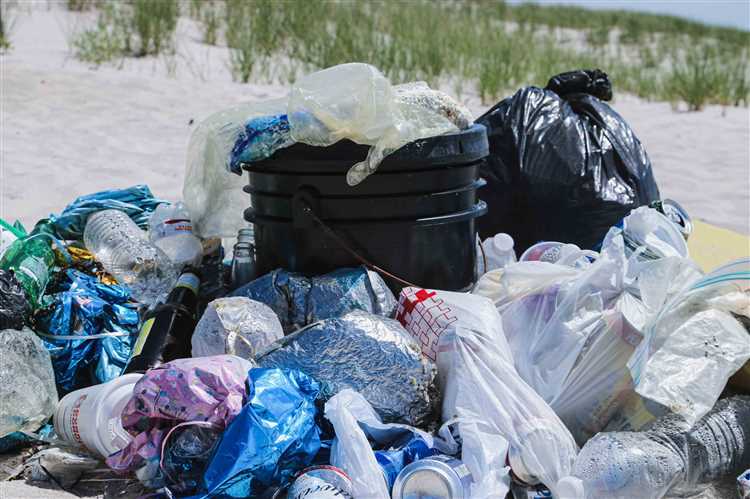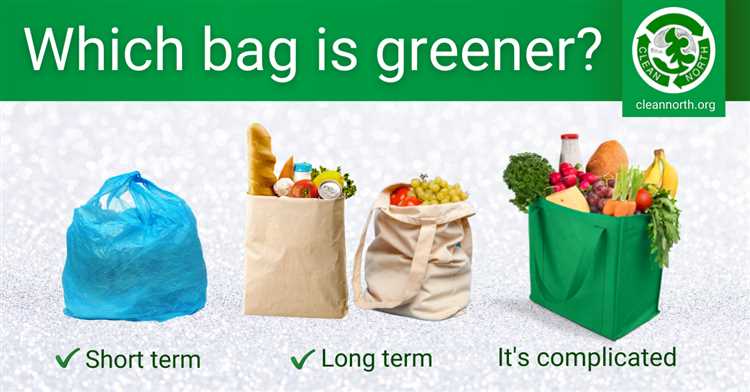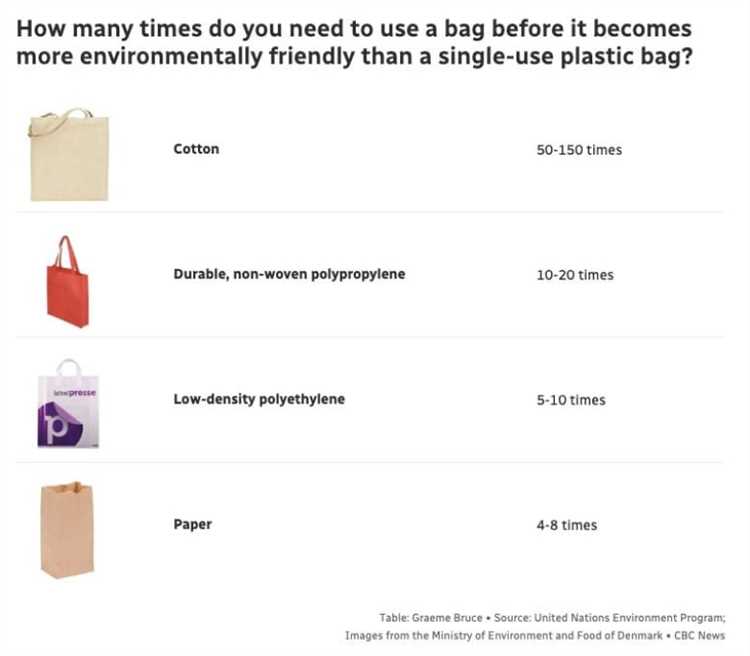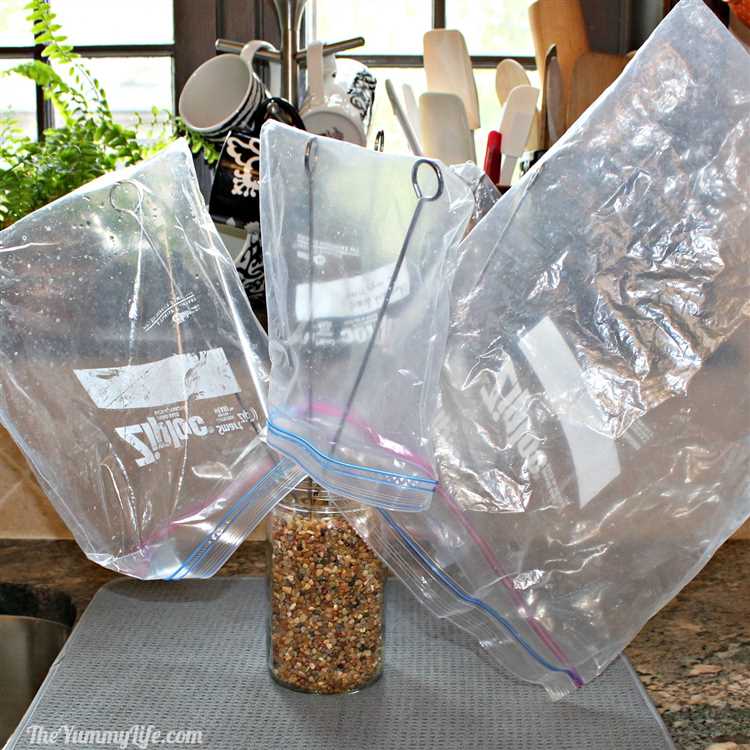
Plastic bags have become an integral part of our daily lives. They are versatile, lightweight, and convenient for carrying groceries, clothes, and various items. However, the question of how many times plastic bags can be reused is a matter of concern for many people.
It is true that plastic bags are not designed to be reused. Most of them are made from thin and fragile plastic that can easily tear or wear out after a few uses. However, with proper care and handling, plastic bags can be used multiple times before they need to be disposed of.
There are several factors that determine the number of times a plastic bag can be reused:
- Thickness: Thicker plastic bags are more durable and can withstand more uses compared to thinner ones.
- Load capacity: Overloading a plastic bag can put stress on the handles and seams, leading to quicker wear and tear.
- Handling: The way a plastic bag is handled can also impact its lifespan. Rough handling, including dragging or dropping the bag, can cause damage.
- Cleaning: Regular cleaning of plastic bags can extend their usability. Washing them with mild soap and water can remove dirt and contaminants.
While it is difficult to give an exact number, on average, a plastic bag can be reused anywhere from one to five times. Keep in mind that this estimate may vary depending on the factors mentioned above.
As a responsible consumer, it is important to consider alternatives to plastic bags, such as reusable cloth bags or biodegradable options. By reducing our reliance on single-use plastics, we can make a significant impact on the environment and help reduce plastic waste.
- Factors Affecting the Reusability of Plastic Bags
- 1. Durability
- 2. Cleaning and Maintenance
- Durability of Plastic Bags
- Conclusion
- Environmental Impact of Plastic Bags
- 1. Pollution
- 2. Non-biodegradability
- 3. Resource Depletion
- 4. Wildlife Disturbance
- Recycling and Repurposing Plastic Bags
- Benefits of Recycling and Repurposing Plastic Bags
- Alternative Uses for Plastic Bags
- 1. Storage and Organization
- 2. Cleaning and Household Chores
- Proper Care and Maintenance of Plastic Bags
- Consumer Attitudes and Awareness Towards Reusing Plastic Bags
- Importance of Consumer Education
- Challenges to Reusing Plastic Bags
- Q&A
- Can plastic bags be reused?
- How many times can a plastic bag be reused?
- What are some ways to reuse plastic bags?
- Is it safe to reuse plastic bags?
- What are the environmental benefits of reusing plastic bags?
- How many times can plastic bags be reused?
- Why is it important to reuse plastic bags?
Factors Affecting the Reusability of Plastic Bags
Plastic bags are commonly used for various purposes, but their reusability largely depends on several factors. Understanding these factors can help individuals make informed choices about how many times they can reuse plastic bags.
1. Durability
The durability of a plastic bag plays a crucial role in determining its reusability. Bags made from thicker and stronger plastics have a higher chance of being reused multiple times. These bags can withstand regular wear and tear, making them more durable and suitable for repeated use.
2. Cleaning and Maintenance
The cleaning and maintenance of plastic bags also impact their reusability. Bags that are easy to clean and maintain are more likely to be used multiple times. Bags that can be easily wiped clean or machine washed are preferable over those that require intensive cleaning methods, such as hand washing or dry cleaning.
To ensure maximum reusability, it is important to follow the recommended cleaning instructions provided by the manufacturer. Regular cleaning and proper maintenance can prolong the life of plastic bags and make them suitable for reuse.
It is worth noting that while reusing plastic bags can help reduce waste, it is important to consider the overall environmental impact of plastic usage. Choosing reusable bags made from alternative materials, such as cotton or jute, can be a more sustainable solution in the long run.
Durability of Plastic Bags

Plastic bags are known for their durability and strength, making them a popular choice for packaging and carrying items. They are designed to withstand the rigors of everyday use and provide a long-lasting solution for transporting goods.
Most plastic bags are made from polyethylene, a material that is highly resistant to wear and tear. This material is known for its strength and ability to withstand heavy loads without tearing or breaking. The durability of plastic bags allows them to be reused multiple times, depending on the level of wear and tear they sustain.
However, it is important to note that the number of times a plastic bag can be reused may vary depending on several factors. These factors include the thickness of the bag, the weight of the items it carries, and how it is handled and stored. A thicker bag is generally more durable and can withstand greater strain, while a thinner bag may need to be replaced more frequently.
Proper handling and storage of plastic bags can also affect their durability. Avoid overloading the bag with heavy items, as this can put excessive pressure on the handles and seams, leading to tears or breakage. Additionally, storing the bags in a cool, dry place can help prevent degradation and extend their lifespan.
It is worth noting that reusing plastic bags is not only a cost-effective solution but also an environmentally friendly practice. By reusing bags multiple times, we can reduce the demand for new bags and minimize the amount of plastic waste generated.
Conclusion

In conclusion, plastic bags are durable and designed to be reused multiple times. The durability of a plastic bag depends on factors such as its thickness, weight capacity, handling, and storage. By properly handling and storing plastic bags, we can prolong their lifespan and contribute to reducing plastic waste.
Remember to reuse plastic bags whenever possible and dispose of them responsibly when they can no longer be used. Together, we can make a positive impact on the environment by making conscious choices about plastic bag usage.
Environmental Impact of Plastic Bags

Plastic bags have become a popular choice for carrying groceries and other items due to their convenience and low cost. However, their widespread use has had a significant negative impact on the environment.
1. Pollution
Plastic bags are a major source of pollution in both land and water ecosystems. When not disposed of properly, they can end up in oceans, rivers, and lakes, posing a threat to marine life. The bags can be mistaken for food by marine animals, leading to ingestion and entanglement, which often result in injury or death.
2. Non-biodegradability
One of the biggest environmental concerns with plastic bags is their non-biodegradability. Unlike other materials, such as paper or cloth, plastic bags can take hundreds of years to decompose. During this time, they break down into smaller microplastics, which can contaminate soil and water and enter the food chain.
Microplastics not only have negative impacts on terrestrial and aquatic ecosystems but can also pose risks to human health. Animals, including humans, may accidentally consume microplastics through contaminated food and water, potentially leading to various health issues.
3. Resource Depletion
The production of plastic bags requires significant amounts of resources, including fossil fuels such as oil and natural gas. The extraction and processing of these resources contribute to air and water pollution, deforestation, and habitat destruction. Additionally, the manufacturing process releases greenhouse gases, contributing to climate change.
Moreover, the disposal of plastic bags often involves landfilling, which takes up valuable space and hampers efforts to reduce waste and promote recycling. The inefficient disposal methods further exacerbate the environmental impact of plastic bags.
4. Wildlife Disturbance
Plastic bags can also cause disturbances in the natural habitats of wildlife. They can get caught in trees, bushes, and other vegetation, creating an eyesore and disrupting the balance of ecosystems. The presence of plastic bags in natural environments can also deter certain species from nesting or foraging in affected areas.
Overall, the environmental impact of plastic bags is significant and far-reaching. To mitigate these effects, it is crucial to reduce plastic bag consumption, promote the use of reusable alternatives, and improve waste management systems.
Recycling and Repurposing Plastic Bags
While it is important to reduce the use of plastic bags and find alternatives, it is also crucial to properly recycle and repurpose the bags that are already in circulation. Plastic bags are not biodegradable and can take hundreds of years to break down in the environment, contributing to pollution and harming wildlife.
One way to recycle plastic bags is to bring them to a recycling center or a designated drop-off location. Many grocery stores and retail stores have collection bins where customers can deposit their used plastic bags. These bags are then collected and sent to recycling facilities where they are processed and turned into new products.
Plastic bags can be recycled into a variety of items, such as new plastic bags, packaging materials, composite lumber, and even synthetic lumber. Recycling plastic bags helps to conserve resources and reduce the demand for new plastic production. It also prevents them from ending up in landfills or oceans, where they can harm the environment.
Another way to repurpose plastic bags is to use them for other purposes before eventually recycling them. Plastic bags can be reused as trash bags, for storing items, or as packing material. They can also be used for arts and crafts projects or repurposed into new household items.
Benefits of Recycling and Repurposing Plastic Bags
Recycling and repurposing plastic bags have several benefits for both the environment and society. Firstly, it helps to conserve resources by reducing the need for new plastic production. This conserves energy and decreases greenhouse gas emissions associated with plastic production processes.
Secondly, recycling and repurposing plastic bags help to reduce the amount of waste that ends up in landfills. By diverting plastic bags from the waste stream, it helps to extend the lifespan of landfills and reduce the need for additional landfill space.
Lastly, recycling and repurposing plastic bags contribute to a more sustainable and circular economy. By turning plastic bags into new products, it reduces the demand for virgin materials and encourages the development of a closed-loop system, where products are recycled and reused instead of being discarded after a single use.
In conclusion, while it is important to reduce the use of plastic bags, recycling and repurposing the bags that are already in circulation is equally important. By properly recycling and reusing plastic bags, we can help to conserve resources, reduce waste, and move towards a more sustainable future.
Alternative Uses for Plastic Bags
While reducing the use of plastic bags is the best solution to combat environmental pollution, there are alternative ways to reuse them before ultimately recycling them. Here are some creative and practical ways to give your plastic bags a second life:
1. Storage and Organization
Plastic bags can be excellent storage and organization solutions. Use them to store out-of-season clothing, bedding, or linens. They can also be used to organize your pantry, by keeping different types of snacks or kitchen utensils separated and easily accessible.
Additionally, plastic bags can be used to keep your shoes protected and organized when traveling. Simply wrap each pair in a plastic bag to prevent dirt or scuffs from getting on your clothes.
2. Cleaning and Household Chores
Plastic bags can be put to good use when it comes to cleaning and household chores. Use them as garbage bags for small trash cans, or as liners for wastebaskets in your bathroom, bedroom, or office. They can also be used to collect pet waste during walks.
For gardening tasks, plastic bags can be used as makeshift gloves to protect your hands, or as covers for delicate plants during unexpected frost or hailstorms.
Remember: Always dispose of plastic bags properly when they are no longer reusable, by recycling them at designated drop-off locations or through plastic bag recycling programs available in your area.
Proper Care and Maintenance of Plastic Bags
Plastic bags may seem like disposable items, but with proper care and maintenance, they can be reused multiple times. By following a few simple steps, you can extend the lifespan of your plastic bags, reducing waste and saving money.
1. Clean and dry your plastic bags after each use.
One of the most important steps in maintaining plastic bags is to keep them clean and dry. By removing any food crumbs or liquids and allowing them to air dry, you can prevent the growth of bacteria and mold, ensuring that they are safe for reuse.
2. Store your plastic bags in a dry and cool place.
To further prevent the growth of mold and mildew, it is important to store your plastic bags in a dry and cool place. Avoid storing them in areas with high humidity, such as bathrooms or basements, as this can accelerate their deterioration.
3. Avoid overloading your plastic bags.
While plastic bags are designed to carry a certain amount of weight, overloading them can lead to tears and damage. To prevent this, be mindful of the weight of the items you are placing in the bag and avoid overstuffing it.
4. Repair any minor tears or holes.
If you notice any minor tears or holes in your plastic bags, it is best to repair them before they worsen. Simply use a clear adhesive tape or a plastic bag repair patch to reinforce the damaged area.
5. Keep your plastic bags out of direct sunlight.
Exposure to sunlight can accelerate the breakdown of plastic bags, making them more prone to tearing and becoming brittle. It is best to store them in a dark place or keep them in a reusable shopping bag when not in use.
By following these simple care and maintenance tips, you can significantly extend the life of your plastic bags and reduce your environmental impact. Remember, reusing plastic bags is a sustainable choice that helps to reduce waste and conserve resources.
| Tip | Benefit |
|---|---|
| Clean and dry after each use | Prevents bacterial growth and ensures safety |
| Store in a dry and cool place | Prevents mold and mildew |
| Avoid overloading | Prevents tears and damage |
| Repair minor tears or holes | Extends lifespan of the bag |
| Avoid direct sunlight | Prevents breakdown and brittleness |
Consumer Attitudes and Awareness Towards Reusing Plastic Bags
Consumer attitudes towards reusing plastic bags play a significant role in their actual reuse. In recent years, awareness about the negative environmental impact of single-use plastics has increased, leading to a growing interest in finding alternatives and reducing waste.
Awareness campaigns and educational initiatives have highlighted the benefits of reusing plastic bags as a sustainable option. Many consumers now understand that by reusing a plastic bag multiple times, they can significantly reduce the amount of plastic waste generated. This knowledge has influenced consumer attitudes and resulted in a shift towards greater acceptance and adoption of reusing plastic bags.
Furthermore, the convenience and cost-effectiveness of reusing plastic bags also contribute to their higher acceptance among consumers. With the implementation of plastic bag bans in various regions, consumers are realizing the need to carry reusable bags and are more inclined to reuse them whenever possible.
Importance of Consumer Education
Consumer education and awareness campaigns have played a crucial role in shaping consumer attitudes towards reusing plastic bags. These initiatives have focused on educating consumers about the environmental impact of single-use plastics and the benefits of reusing bags.
By providing information about the number of times plastic bags can be reused and highlighting the potential reduction in plastic waste, consumers are empowered to make more informed choices. This increased knowledge has led to a greater willingness to engage in reusable practices, including reusing plastic bags.
Challenges to Reusing Plastic Bags

Despite the growing awareness and positive consumer attitudes, there are still certain challenges to reusing plastic bags. One challenge is the perception that reusing plastic bags may be unhygienic or unsanitary. This concern can be addressed through proper cleaning and maintenance practices, ensuring that reusable bags are kept clean and free from any contaminants.
Another challenge is the availability and accessibility of reusable alternatives. Consumers need access to nearby stores or markets that provide reusable bags, especially in areas with limited options. Addressing this challenge requires the cooperation of retailers and policymakers in making reusable bags easily available to consumers.
| Factors Influencing Consumer Attitudes | Consumer Behavior |
|---|---|
| Awareness campaigns | Inclination towards reusing plastic bags |
| Education initiatives | Reduction in plastic waste |
| Convenience and cost-effectiveness | Greater acceptance and adoption |
| Perceived hygiene concerns | Maintenance practices |
| Availability and accessibility of reusable alternatives | Cooperation of retailers and policymakers |
Q&A
Can plastic bags be reused?
Yes, plastic bags can be reused multiple times before they are disposed of.
How many times can a plastic bag be reused?
The number of times a plastic bag can be reused varies depending on factors such as the thickness of the bag, how it is used, and how well it is cared for. On average, a plastic bag can be reused anywhere from a few times to several dozen times.
What are some ways to reuse plastic bags?
There are many ways to reuse plastic bags. Some ideas include using them as garbage bags for small trash cans, using them for pet waste disposal, using them as packing material when shipping fragile items, or using them as storage bags for organizing small items.
Is it safe to reuse plastic bags?
Reusing plastic bags can be safe as long as they are kept clean and in good condition. However, it is important to note that plastic bags can harbor bacteria and other contaminants, so it is important to wash them regularly if they are being reused for food storage or other sanitary purposes.
What are the environmental benefits of reusing plastic bags?
Reusing plastic bags can help to reduce waste and conserve resources. By reusing a plastic bag multiple times, it can potentially replace the need for multiple new bags, reducing the overall demand for plastic bag production. This can help to decrease the amount of plastic waste that ends up in landfills or as litter in the environment.
How many times can plastic bags be reused?
Plastic bags can be reused multiple times until they start showing signs of wear and tear. On average, a plastic bag can be reused about 4-5 times, but this may vary depending on the quality of the bag and how it is used.
Why is it important to reuse plastic bags?
Reusing plastic bags is important because it helps reduce waste and promotes environmental sustainability. By reusing bags instead of throwing them away after a single use, we can reduce the amount of plastic waste that ends up in landfills or pollutes our environment.